LG 29EA93 Ultrawide Display - Rev. 1.09
by Chris Heinonen on December 11, 2012 1:20 AM ESTLG 29EA93—Display Uniformity
Display Uniformity is where I am really worried about the LG 29EA93. It has a wider panel than anything typically produced, which means a whole new backlighting system than has been used before; that can easily lead to irregularities compared to a 16:9 panel. The ANSI uniformity test using a 5x5 grid was truly revealing when looking at the white uniformity on the 29EA93.
With the center set to 200 nits, the average of the surrounding zones was a very nice 200 nits, giving you a far more uniform center of the image than any monitor I’ve used to date. The outside edge has an average light level of 193 nits, making it far brighter than most monitors outside edges. Overall the average brightness for all 25 zones was 195 nits, which is the best result in quite some time. For white uniformity, the 29EA93 is truly a cut above.
Black uniformity is excellent as well, with only a couple spots that are a bit brighter than other zones, but an average result across the display of 0.19 nits with a center of 0.186 nits. The two lower corners have a bit of backlight bleed that is visible when a black screen is up and they measure the worst of anywhere on the screen. Overall, even when the different ratio isn’t accounted for, the 29EA93 scores quite well here.
Contrast uniformity is just excellent on the whole. Only one zone out of 25 falls below 950, and 22 of the zones are above 1000:1. The average contrast ratio for the whole screen is 1046:1 and is a really superb overall number for an IPS panel. I would say that the LG is one of the more uniform panels I’ve tested to date, with contrast ratios that are better than most displays on the whole.
Color Uniformity is also quite good, other than the lower-right corner, which is where there is the most visible backlight bleeding on the display. The average dE across the whole display is a solid 1.87, and the worst corner is only 2.63 as well.
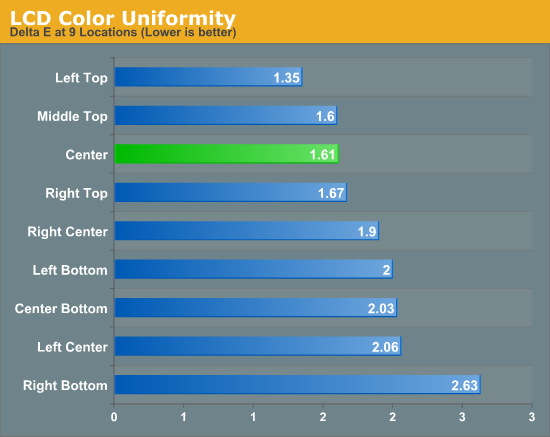
Overall, the LG 29EA93 is the most uniform consumer monitor I have tested to this point and does a remarkable job overall. I was worried at first that the different aspect ratio might lead to worse performance in this area, but it seems that whatever LG had to engineer for this works remarkably well and produces an overall uniform image across the whole display.


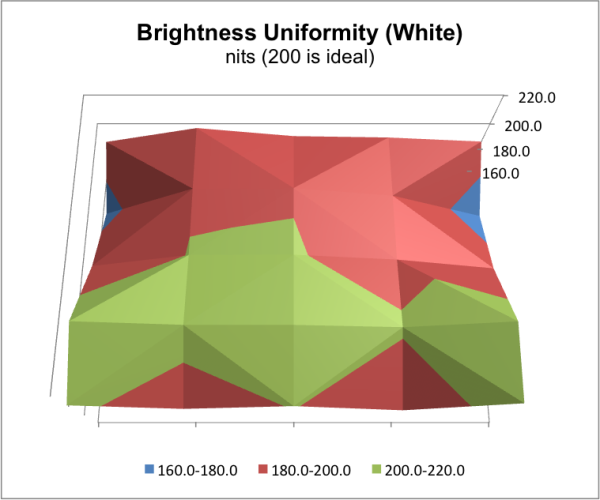
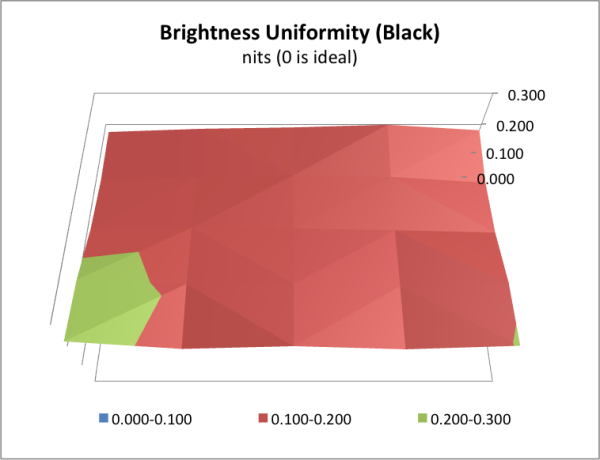
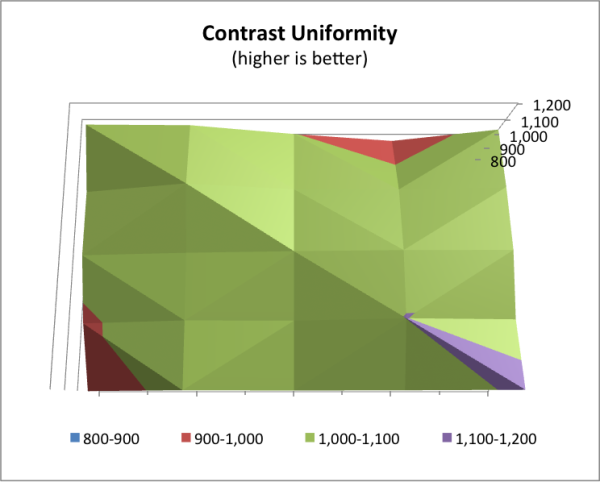
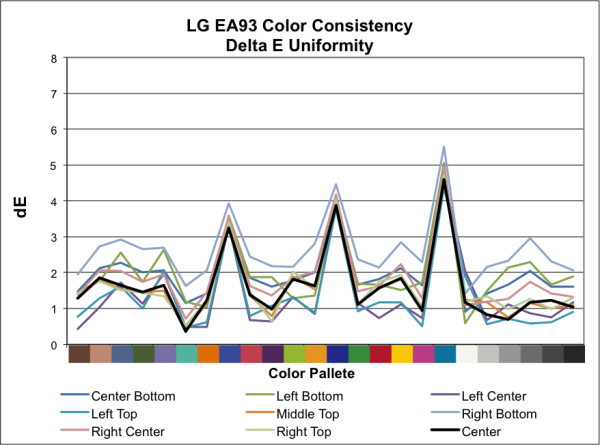
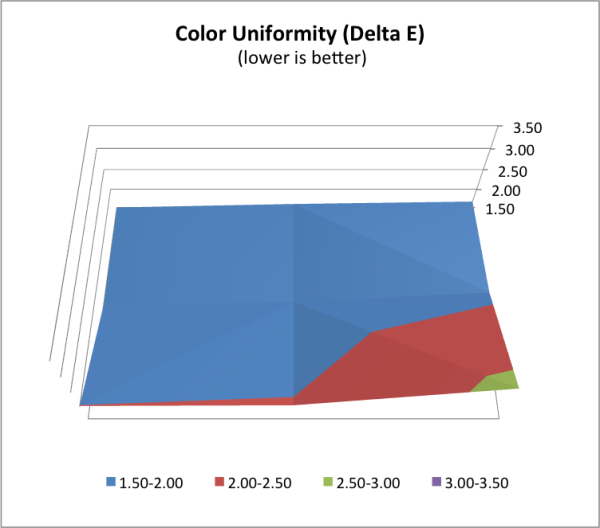








90 Comments
View All Comments
Rick83 - Tuesday, December 11, 2012 - link
So you say " In my very casual use this didn’t bother me"...and then use that as your main argument against the screen?
That is somewhat strange. If you can only quantify the issue, but not qualify it, then you shouldn't use it as such a strong argument.
Finally, it would be great to get a link back to the methodology used to measure monitor latency. Prad had a huuuge article on that, and I'm not even sure that the methodology you use is actually giving accurate results.
nathanddrews - Tuesday, December 11, 2012 - link
I don't think he was unclear. Input lag is really only a big issue when dealing with really fast action games. For slower paced games and cinefiles (assuming you can adjust latency of your audio source to match) input lag is not as important. So while I can understand the appeal of an extra-wide display for immersive gaming, the high latency of this display cancels that out.Prad? They established that lag testing applications are accurate enough. In the end, being accurate to 1fps is more than sufficient. Look at this chart showing the many different testing methods. They're all pretty close.
http://www.prad.de/en/monitore/specials/inputlag/i...
I will say that I am surprised that the display was tested at 1920x1080 rather than the native resolution. How do we know that the non-native resolution didn't contribute to observed latency? I guess I would have liked to see the native resolution tested to be sure. As a gamer and "cinefile", I would certainly attempt to run the monitor at its native resolution whenever possible, using FOV hacks as necessary.
Rick83 - Tuesday, December 11, 2012 - link
"Values which have been arrived using the old methods to date cannot be compared with these values, since their systematic errors alone often exceed the values from the new method multiple times."So clearly, the method that is used matters.
nathanddrews - Tuesday, December 11, 2012 - link
I understand, but the results - faulty or not - are roughly all within 1fps or real-world perception. Displays that have low latency using the old method still have low latency using the new methods, likewise with high latency. Other than objective purity, it doesn't seem to matter.cheinonen - Tuesday, December 11, 2012 - link
I haven't written up how SMTT is used, but TFT Central did a very through write-up of it in comparison to other methods and how the results were here:http://www.tftcentral.co.uk/articles/input_lag.htm
I plan for an article going over all of the testing methods in more detail soon.
jjj - Tuesday, December 11, 2012 - link
Not very sure why you asume the target was movies, i see that more as an unintended benefit and this as just an alternative to using 2x1080p screens.Maybe you would be happier with higher vertical res,guess there is no reason for them to not to that too at some point.The pricing is rather unfortunate, the Dell was quite a bit cheaper on BF and the input lag takes away so much of the benefit of having this AR.
Wish someone (hint Samsung) would make a 3420x1440 (more or less) with flexible display where the curve can be adjusted.That would be way fun,maybe even help revive a bit PC gaming.
cheinonen - Tuesday, December 11, 2012 - link
The movie assumption comes more from the presence of dual HDMI inputs, a CMS, and an MHL input than from the aspect ratio. Those lean more towards it being a shared desktop and TV/Gaming display, and once it's used for that then movies come more into play. Without the extra inputs and control I'd think it's more likely a dual monitor replacement. I think it's a bit of both, but needs some work.wsaenotsock - Tuesday, December 11, 2012 - link
So this is how laptop screens will look in 5 years after this ratio catches on and homogenizes the global panel supply again?madmilk - Wednesday, December 12, 2012 - link
You could buy a Macbook.peterfares - Wednesday, December 12, 2012 - link
I really hope this doesn't happen. 16:10 was so much better for computer usage, but 16:9 is still acceptable. This is just stupud. 27" WQHD screens are cheaper and much better, too.